LAST YEAR, KROGER HIT $90.4 BILLION IN ANNUAL SALES ACROSS TWO-DOZEN BANNERS IN 30-PLUS STATES, EVEN AS IT RAISED SUSTAINABILITY TO THE NEXT PLATEAU.
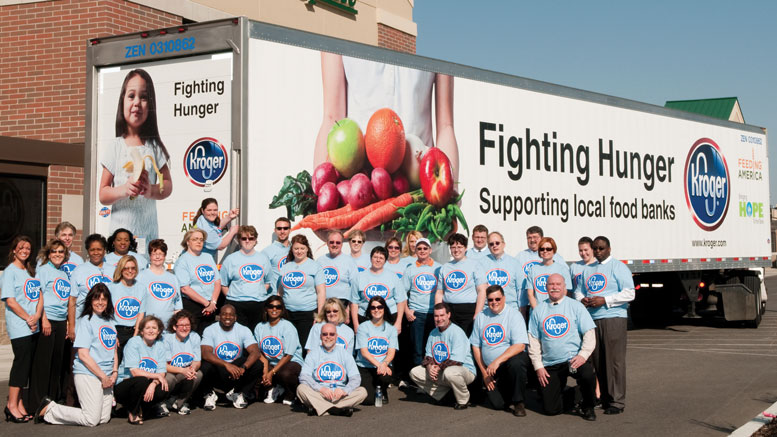
Countering trends by racking up multiple quarters of consecutive same-store sales increases through the recession and economic downturn, the strategy seems to be working.
In a world where corporate executives drive or discard sustainability initiatives based on the bottom line, Kroger champions the social humanitarian leg of sustainability, so often subjugated or played superficially as a marketing tool. Yet Kroger’s social initiatives pack a punch that parallels its size, reverberating through communities with life-altering outcomes.
Produce executives should take notice, as most of Kroger’s social initiatives channel fresh fruits and vegetables, beseeching industry opportunity. Many of these programs, whether it is through donations to charitable groups or through produce department volunteerism, touch on a range of social issues, from the fight to end hunger and addressing the obesity epidemic, to health and nutrition issues and supporting environmentally friendly, locally grown and state agriculture programs.
Ironically, Kroger’s success stems from an uncanny ability to morph from corporate conglomerate grandiosity to an independent, neighborhood store mindset. The company generates a groundswell of support by engaging and enabling its employees — more than 330,000 strong— as well as growers, suppliers and customers.
Kroger’s mantra is to empower those throughout the company to stay nimble and attentive to local community needs. This undertaking could seem daunting with 2,400-plus stores dispersed among its varied super
market banners including Kroger, City Market, Dillons, Jay C, Food 4 Less, Fred Meyer, Fry’s, King Soopers, QFC, Ralphs and Smith’s. The mission, however, is rooted in historic precedent.
Deep Roots In Charity
Kroger’s pledge to social sustainability is personal, deep and committed. This is not a fleeting trip to the altar. “We have pictures during the Depression of founder Barney Kroger giving away food to the hungry, opening his arms to people lining up at the store for day-old bread,” says Lynn Marmer, senior vice president of corporate affairs, chief sustainability officer. “So the concept of giving was always there. However, the ability to scale that to hundreds and hundreds of stores, each facing different criteria, has required real partnership,” she says, of the infrastructure, logistics and other complexities involved in building and running Kroger’s Perishable Donations Partnership (PDP) program.
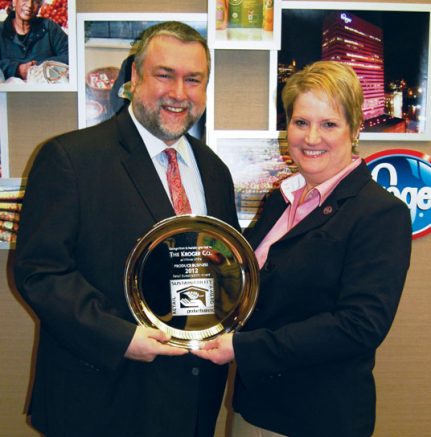
With participation at almost 90 percent of Kroger’s stores, PDP generated 41 million pounds of food, or an equivalent of some 35 million meals, in 2011, and is on trend to match those numbers this year. In the spirit of the common good, Kroger has no qualms sharing its innovative program model with retail competitors, including discussions with some of Kroger’s fiercest competitors, says Marmer.
“We’re happy to pass on our learning. Many times it’s the smaller grocers who are overwhelmed by the idea,” adds Janet Ausdenmoore, manager of corporate affairs, and one of the chief staff members who is instrumental in cause-marketing initiatives, including managing the Kroger Foundation, its non-profit organization that makes grants to other charities, schools and public entities.
“PDP wasn’t an easy program to implement and scale, and there were barriers we had to overcome tied to food safety from both sides of the spectrum,” Ausdenmoore continues. “First, internally for the food safety and risk management teams, we had to get comfortable partnering with an outside agency and developing and monitoring standardized guidelines and certifications; then, training employees on handling procedures and insuring proper storage, refrigeration and temperature control once the product leaves our facility.”
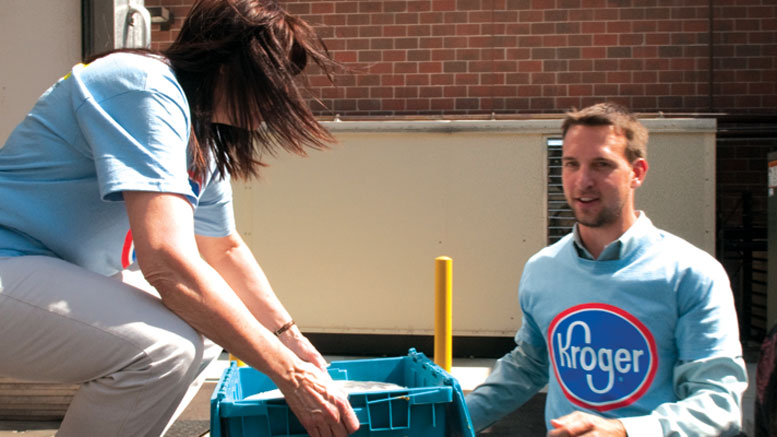
Kroger’s commitment to alleviating hunger and doing the right thing wasn’t about “going green,” she says. However, putting these causes under the sustainability umbrella raises them to the level of an institutional imperative; looking through the sustainability lens creates a collective conscience as a community, she explains.
PDP’s genesis began eight years ago, pulling from programs within specific banners and looking at what other supermarket chains were doing, according to Marmer. “We looked at what our Fred Meyer folks were doing with food rescue in the Pacific Northwest, a joint effort with some local food banks collecting fresh food that needed to be turned around quickly, and to Food Lion in the South, where it was happening on a very small scale.”
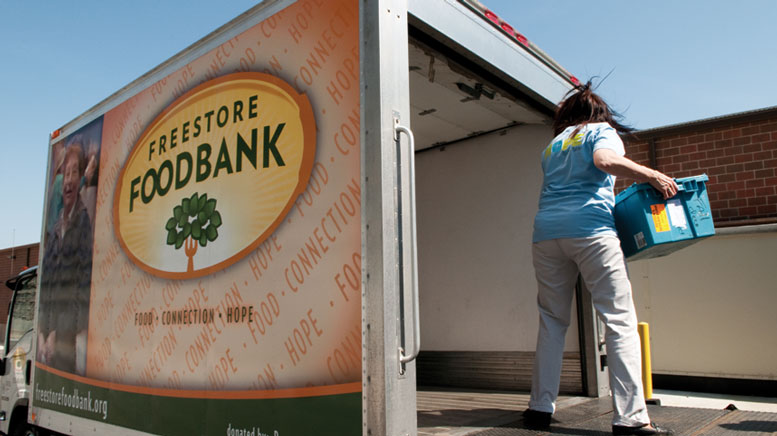
Catapulting PDP, Kroger teamed up with Feeding America, the country’s largest domes-tic hunger-relief organization, which orchestrates a network of some 200-member food banks. “I spent 15 years on the board of a local food bank, so I understood the importance and challenge of offering variety and fresh nutritious items like healthy fruits and vegetables,” says Marmer.
“Food banks live and die on excess,” a crude reality, says Eric Davis, director of retail product resourcing at Feeding America, head-quartered in Chicago, IL. [See his interview detailing the Kroger partnership on page 32]. Yet the food industry continues to become much more efficient, managing leaner inventories and cutting out shrink.
Role Of Produce
Due to its highly perishable nature, produce presents further challenges, according to Joe Miskimins, Kroger’s vice president of produce and floral, who remains undeterred in efforts to grow the produce department’s participation in the program.[Miskimins discusses sustainability from a produce perspective on page 44-45].
PDP’s survival hinges on the frequency of pickups and seamless logistics. To that end, PDP is managed through Kroger’s shrink department, rather than public affairs. “The reason the shrink department has taken over PDP operations is because we have more boots on the ground. Operations people in our stores and in our districts can help us to educate and follow up on a regular daily basis,” says Ed Taylor, director of shrink management, pointing out that Ausdenmoore and Marmer have done a great job developing relationships with food banks.
Produce is the biggest challenge for PDP. “We need better execution through the supply chain. Turning product is key. How can we increase pickup frequency?” asks Taylor. “As we look through the enterprises, the divisions and food banks, we see variable sophistication and frequency of pickups with donations,” he continues.
Kroger began pilots at Fred Meyer, and its Fry’s division in Arizona is just getting its feet wet, Taylor reports. “We knew it was tricky going in, modifying guidelines and Best Practices for produce,” he says, adding, “a big opportunity is in bulk produce — the harder items, such as apples and potatoes.”
Kroger also has expansion plans in play for its 212-store Atlanta division, as well as its Indiana operations, says Max Ostermyer, logistics shrink manager. “We still have a lot of work to do in Atlanta, but we’ve got the commitment from St. Vincent De Paul and the Atlantic Community Food Bank to do that. Jay C Food Stores is a little subset of stores that we have in southern Indiana. Last year, they had one store in the PDP program and we got commitment at the end of last year to add another 29 stores to the program by this year, so that’s a big win for us as well.”
“Produce has always been a part of PDP, but we’ve recently put new emphasis on it, re-launching the program to increase produce donations,” says Kelly McGamon, public affairs leader for King Soopers in the Colorado region. “It comes at an important time with so much economic hardship,” she says.
PDP has been embraced by associates, the community and management, she continues, noting that the total amount of food donated through the program in Colorado translates to 3,550 meals a day. “Many people can’t afford fresh produce. While the donated items may not be to the standards we sell, they are still edible, nutritious, good quality fruits and vegetables,” she says.
Adds Marmer: “We knew it was going to be a powerful combination; it was just getting it right so we could have it run on auto pilot in each place, while adjusting to variances on a store-by-store basis. That really has come about because of the belief and the dedication of our own store associates and store managers.”
Charitable programs envelop the Kroger culture, according to Bill Dankworth, vice president of grocery merchandising, and point person for Bringing Hope to the Table, an annual merchandising-driven program that gives back to charity. Essentially, the way Bringing Hope to the Table works is that Kroger collects money earmarked in trade funds from select suppliers in exchange for guaranteeing quality promotion and merchandising of their brands, he explains. In turn, Kroger donates that equivalent amount of money to local food banks in the communities that Kroger operates, while Feeding America also gets a portion.
Since its launch seven years ago, the size of the program and amount of money donated has stayed constant — $4 million cash value, or $3 million in cash each year and $1 million in product.
“We select 30 suppliers, not because we don’t want the additional dollars, but we could not give quality merchandising if the space got too crowded. Also, since it is a merchandising event, we have to focus on items most relevant for our customers,” he says, adding, “We’re doing this for an altruistic reason, so look for ways to make it a better program.”
A new door may open for produce companies. “Bringing Hope to the Table is almost 100 percent grocery right now, but we encourage the idea of extending it to perish-able categories like produce, meat and deli because these are areas of the store not used yet,” says Dankworth.
“We would love to have produce companies participate and get our store counterparts involved.” It’s much easier to do a UPC-coded product than it is to do a stalk of romaine lettuce, he points out, but there are plenty of UPC-coded items now in the produce department, including bagged salads and dried fruits and nuts that are incredibly nutritious.
“Food is a point of entry for providing hope to people who have lost jobs or are struggling,” Dankworth continues. “First of all, we have to take care of people nutritionally and start to move them into more paths of self reliance. And because we’re a food company, that fits very nicely with our core business and our mission to fight hunger in America as our Number One charitable platform.”
At the corporate level, Kroger champions three major causes: Hunger — Bringing Hope to the Table; Breast Cancer — Giving Hope a Hand; and this year, it has added a new partnership to support the fundraising of USO’s —Honor our Heroes.
According to Ausdenmoore, while these are national priorities, the execution still happens at the local level. That money is actually allocated out to the divisions, so when a check is issued from the Kroger Foundation, it is going to a King Soopers, for example, and the local divisions drive how these funds are allocated.
The same thing applies to Kroger’s disaster-relief efforts. In fact, during an early March visit by PRODUCE BUSINESS editorial staff to Cincinnati, Kroger was dealing with the aftermath of several tornadoes that had touched down in the Greater Cincinnati area. According to director of external corporate communications, Keith Dailey, teams were put into place to evaluate community needs and work to provide non-perishable donations to victims.
All divisions offer grassroots fundraising opportunities. Kroger empowers its customers to choose where the money will go, allowing a percentage of their grocery spending to be credited toward organizations tied to their interests. “It’s all returned to local communities, elementary schools, food pantries, girl scouts, soccer teams, and it’s very meaningful,” says Ausdenmoore. Overall, these efforts raise about$40 million annually.
Locally Grown
In addition to reaching out to local charities to support Kroger’s many communities, the corporation also sees its engagement with local farmers as part of its sustainability mission.
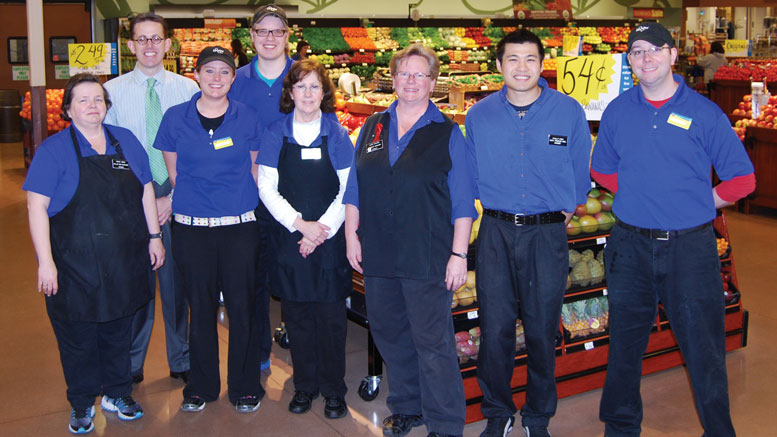
“We’re all touching sustainability these days,” says Carl York, public affairs leader for the Mid-Atlantic marketing area, which comprises all Kroger stores primarily in North Carolina, parts of South Carolina and West Virginia. “The whole locally grown business for us is about supporting farmers and helping neighbors, especially in a tough economy.”
“Promoting local resonates well with our customers, builds loyalty and we get the added bump of sustaining the community,” he says. “How great it is for our own associates, who are so proud that we carry local products? There is something magical about that kind of involvement. Sometimes that gets overlooked,” he continues.
“Produce is our crown jewel, and nothing says fresh better than local produce. At the same time, we’re not interested in partnering just to partner. It has to be great quality at a great price, and we make sure product is within a certain area, tells a story and is meaningful to the shopper. After all, in our business it comes down to what sells,” he says, noting customer anticipation each year in Virginia during the holidays, when families come to Kroger to pick out their locally grown Christmas trees from eye-catching displays. “Virginia customers remember that.”
“When we do customer surveys, we get high marks for buying local,” says Gary Huddleston, public affairs leader in Dallas, TX, for Kroger’s Southwest marketing area, including Texas and Louisiana. “Our customers embrace it and realize product is fresher because it gets to the store quicker and should improve the price as well,” he contends.
“Especially for a large company like Kroger, we make sure that we’re more local-ized in the community,” Huddleston says, noting that partnering with state agriculture departments on promotional programs is a great way for Kroger to show that it supports local growers and farmers.
In Texas, for example, “we have a relation-ship with Texas Department of Agriculture Commissioner Todd Staples, who has a staff that travels the state visiting retailers encouraging them to buy Texas produce and then providing marketing materials, camera-ready art and logos,” he explains. Kroger obliges, filling shelves with Texas produce based on availability, including grapefruit, cantaloupe, onions, mushrooms and blueberries, he says, pointing out that the Buy Texas program has expanded dramatically throughout the state, in no small part due to Kroger’s participation.
“Our customers love local and we love local, but it’s a challenge when you operate hundreds of stores to make sure that you’ve got all the systems and the execution right,” says Marmer. Kroger capitalizes on balancing centralized procurement while enabling both store-level and regional buying.
“Store-level buying does exist; it’s just not something that can be done in isolation,” she emphasizes. “We’ve got expert merchandisers in local markets, who are able to say, ‘Hey, there’s a great beet farmer here,’ or ‘This local tomato grower will have enough supply.’”
In some instances, Kroger collaborates with farmers to build a program, which could involve training on growing practices and help in meeting the food safety prerequisites and certifications. Regardless of size or circumstances, “you can’t be exempted from any food safety requirements,” Marmer emphasizes.
Consumers clamor for Olathe corn from Colorado. “We work with those suppliers and do our best to try to have enough Olathe corn to sell not only inside of Colorado, but also in other markets,” she says.
Companies have created all kinds of definitions for what constitutes “local,” yet Kroger is less preoccupied with a standardized definition, but rather appealing to its customers’ expectations, which differ based on geography and demographics, according to Nate Shepley-Streed, who was recently promoted to a sustainability-specific role, working to ensure that Kroger’s Corporate Brand initiatives are in alignment with Kroger’s larger sustainability commitments. (In Kroger’s journey to build its sustainability platform and accelerate progress, the company also recently named Susanne Lindsay as its first director of sustainability.)
Kroger fosters an environment where its associates feel part of the process and that their input is valued. A quintessential example is the Cultural Council. A diverse group of employees representing different positions and aspects of the company come together and act as a sounding board for what’s going on and provide feedback, direction and guidance. From senior executives to merchandisers to entry-level employees, the membership rotates to stimulate varied view-points and provides a really great leadership opportunity, explains Ausdenmoore.
Beyond Charity
Marmer points out that beyond PDP’s humanitarian attributes, the program also saves $1.2 million in waste expense by not throwing away edible product. In efforts to reduce waste, Kroger walks the line on what’s desirable with what’s feasible. In many cases, a decision has to be made in the backroom of a store to deter-mine whether a product can be donated or composted. The trick about composting, Marmer continues, is putting it in the context of the whole supply chain, separating out the compostable from the non-compostable, and who has the infrastructure to take that and do something with it.

“Actually, we’re going to try and pilot com-posting in every division and see where it makes the most sense to scale it down across multiple stores,” says Streed. Much depends on finding local composting companies that can take that on, assessing transportation miles and fees and where it makes the most financial sense, he adds.
“Discussing labor issues [and their relationship to the subject of composting], we came up with the three-second rule,” says Ted Julian, senior manager of corporate expense/sanitation/sustainability. If it takes the associate more than three seconds to prepare a product for composting, it doesn’t make sense.
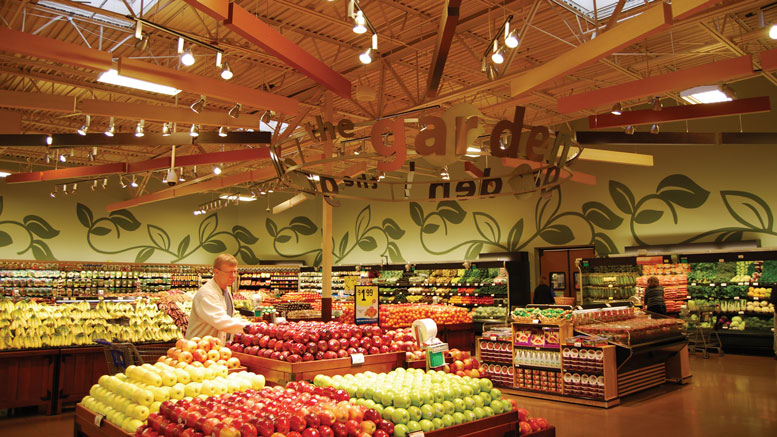
It’s a mindset, he continues. “In our industry, it’s pennies, not dollars, but pennies add up real fast extrapolating across 2,400 stores. Sustainability has become a buzzword tagged on to a title, but we’re the guys in the trenches, going to the landfills, charged with finding ways to take costs out of the business. We’d love to be doing composting everywhere, but the infra-structure is not there yet.”
In the same way, while the firm has dabbled in LEED-certified stores at the Fred Meyer chain in Oregon, Kroger has not found the pay-back that it feels is necessary to justify the cost of LEED certification. “We’ve made a personal choice as a company to more likely pursue an Energy Star certificate,” says Marmer.
Streed adds, “In some cases, if you look at our EPA certificate, we would meet those LEED requirements when comparing carbon footprint and water usage, but Kroger sacrifices the marketing image that accompanies that LEED aura.”
Some things make sense everywhere with new technologies, such as installing LED lights. “If you have a capital budget that’s a very large one, as we do, that budget has competition for new stores, technology, all kinds of things, including more sustainable or alternative energy sources, so you have to pick and choose,” Marmer reasons.
“We shouldn’t be the tail wagging the dog,” says John Winkels, senior director of logistics engineering and network strategy, emphasizing the need to step out of your silo and think about the whole picture. “There’s often a healthy tension when weighing the alternatives. For example, deliveries every other day might be much more efficient, but we think that every-day deliveries are the right answer.”
It isn’t hard to get people excited about working on sustainability projects; even the guy on the forklift feels invested. “And Kroger employees are not shy about holding us accountable on sustainability,” says Winkel.
Turning to the company’s annual sustain-ability report, David Dillon, chairman and CEO, touts some astronomical energy and waste-reduction figures and lofty goals:
• Since 2000, the company has reduced overall energy consumption by 30 percent.
• In 2010, Kroger stores and manufacturing and distribution facilities recycled more than 1.2 billion pounds of corrugated card-board and paper.
• In 2010, through better bagging techniques and increased sales of reusable bags, Kroger saved more than 159 million plastic bags, more than 35 percent of the way to its goal of saving a billion bags by 2014.
• With a collective transportation fleet logging in over 295 million miles from distribution centers to stores, Kroger improved its fleet efficiency by 8 percent in 2010, compared to 2009. (Its goal is to improve fleet efficiency by 40 percent by 2012.)
Kroger is no shrinking violet on business-savvy strategies, and executives are well aware of the dramatic cost savings sustainability measures can generate. For Kroger, those numbers are at times mind-boggling. Weighing costs/benefits, Kroger’s priorities will always remain true to its founding principles, grounded in social sustainability.





